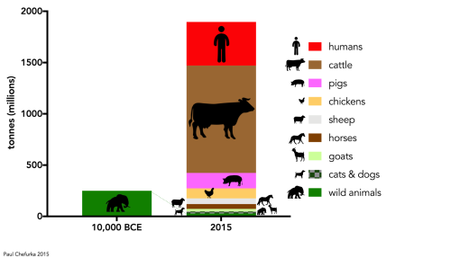
I often find myself in a position explaining to non-professionals just how bad the state of global biodiversity really really is. It turns out too that even quite a few ecologists seem to lack an appreciation of the sheer magnitude of damage we’ve done to the planet.
The loss of biodiversity that has occurred over the course of our species’ time on Earth is staggering. This loss is now truly planetary in scale and caused by human actions, albeit the severity of which is unequally distributed across the globe1. While Sandra Díaz and company recently summarised the the extent of the biodiversity crisis unfolding1 well in their recent synopsis of the Intergovernmental Science-Policy Platform on Biodiversity and Ecosystem Services (IPBES)2 report, I’m going to repeat some of the salient summary statements here, and add a few others.
- The biomass of terrestrial vegetation worldwide has halved over human history3, with a corresponding loss of more than 20% of this realm’s original biodiversity1.
- More than 70% of the Earth’s land surface has been altered by humans1.
- There have been over 700 vertebrate1, and nearly 600 plant4, extinctions recorded since the 16th Century, and many more species have likely gone extinct unnoticed5.
- Massive population declines that are the precursors to extinction have also occurred worldwide; since only 1970, more than 60% of all terrestrial vertebrate individuals have disappeared6, such that there are now at least one million species threatened with extinction6 out of an estimated 7.3– 10.0 million eukaryotic species on the planet7.
- The total global biomass of wild animals today is < 25% of what it was during the Late Pleistocene8, and even insect species appear to be in rapid decline in many parts of the world9-13.
- There is now less than 15% of the original wetland area that was present during the 18th Century14, and over three-quarters of rivers more than 1000 km long no longer flow freely along their entire course15
- Over two-thirds of ocean area has been compromised to some extent by human endeavour16
- Live coral cover on reefs has halved since the mid-19th Century17, seagrass extent has been decreasing by 10% per decade over the last century1, kelp forests have declined by nearly 40%18, and the biomass of large predatory fishes is now less than a third of what it was last century19
- Of the estimated 0.17 Gt of biomass of terrestrial vertebrates on Earth today, most of this is represented by livestock (59%) and living human beings (36%) — only about 5% of this total biomass is taken up by wild mammals, birds, reptiles and amphibians8
- Even our domesticated species are in decline — some 10% of domesticated breeds of mammals have become extinct in human history, with more than 1000 others threatened with extinction20
- Even cultivated plants are becoming threatened, with about 200 cultivated species threatened with extinction21, and a global homogenisation of food crop species used to feed the world over the last 50 years22
All this means that we are now without a doubt well within a sixth mass extinction event.
Next time someone you know argues that the natural world isn’t that poorly off, you can show them this rather depressing list of facts to the contrary.
References
- Díaz et al. Pervasive human-driven decline of life on Earth points to the need for transformative change. Science 366, eaax3100 (2019)
- Intergovernmental Science-Policy Platform on Biodiversity and Ecosystem Services. Global Assessment Report on Biodiversity and Ecosystem Services. (IPBES Secretariat, Paris, France, 2019)
- Erb et al. Unexpectedly large impact of forest management and grazing on global vegetation biomass. Nature 553, 73-76 (2018)
- Humphreys et al. Global dataset shows geography and life form predict modern plant extinction and rediscovery. Nat. Ecol. Evol. 3, 1043-1047 (2019)
- Tedesco et al. Estimating how many undescribed species have gone extinct. Conserv. Biol. 28, 1360-1370 (2014)
- WWF. Living Planet Report 2016. (WWF, Gland, Switzerland, 2016)
- Mora et al. How many species are there on Earth and in the ocean? PLoS Biol. 9, e1001127 (2011)
- Bar-On et al. The biomass distribution on Earth. Proc. Natl. Acad. Sci. USA 115, 6506 (2018)
- Bidau. Doomsday for insects? The alarming decline of insect populations around the world. Entomol. Ornithol. Herpetol. 7, 1000e1130 (2018)
- Hallmann et al. More than 75 percent decline over 27 years in total flying insect biomass in protected areas. PLoS One 12, e0185809 (2017)
- Lister & Garcia. Climate-driven declines in arthropod abundance restructure a rainforest food web. Proc. Natl. Acad. Sci. USA 115, E10397 (2018)
- Powney et al. Widespread losses of pollinating insects in Britain. Nat. Comm. 10, 1018 (2019)
- Forister et al. Declines in insect abundance and diversity: we know enough to act now. Conserv. Sci. Pract. 1, e80 (2019)
- Davidson. How much wetland has the world lost? Long-term and recent trends in global wetland area. Mar. Freshw. Res. 65, 934-941 (2014)
- Grill et al. Mapping the world’s free-flowing rivers. Nature 569, 215-221 (2019)
- Halpern et al. Patterns and emerging trends in global ocean health. PLoS One 10, e0117863 (2015)
- Frieler et al. Limiting global warming to 2 °C is unlikely to save most coral reefs. Nat. Clim. Change 3, 165-170 (2013)
- Krumhansl et al. Global patterns of kelp forest change over the past half-century. Proc. Natl. Acad. Sci. USA 113, 13785 (2016)
- Christensen et al. A century of fish biomass decline in the ocean. Mar. Ecol. Prog. Ser. 512, 155-166 (2014)
- FAO. The State of the World’s Animal Genetic Resources for Food and Agriculture. (Food and Agriculture Organization of the United Nations, Rome, Italy, 2016)
- Hammer & Khoshbakht. Towards a ‘red list’ for crop plant species. Genet. Resour. Crop Evol. 52, 249-265 (2005)
- Khoury et al. Increasing homogeneity in global food supplies and the implications for food security. Proc. Natl. Acad. Sci. USA 111, 4001 (2014)

